|
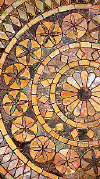
|
So just what is a tile? Put simply, a tile is a
shaped segment of clay which has been fired – or baked – which can then be
used to pave floors or decorate walls. The most important early users of
tiles in Britain were the medieval abbeys, whose pavements used either
coloured geometric shaped tiles in mosaic patterns or…..
|
|

|
…..square tiles with designs of a contrasting
colour indented into the surface. They were often reddy-brown with the
design in buff, and the Chapter House at Westminster Abbey has one of the
most famous of these floors, its designs including images of kings.
|
|

|
Production of these decorated tiles became a
major industry which survived until the middle of the 16th century, when
colourful tin-glazed tiles began to be imported from Holland. They became
very popular during the 17th and 18th centuries, and were known as
delftware after one of the most important manufacturing centres.
|
|

|
Eventually delftware tiles were produced in
England, notably in Liverpool, in addition to being imported, and were used widely for decoration of walls and fireplaces,
especially during the 18th century but also well into the 19th.
|
|
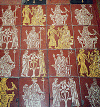
|
The 19th century gothic revival encouraged an
interest in all things medieval, including inlaid tiles. Herbert Minton of
Stoke-on-Trent was the most important of the early Victorian tile
manufacturers; he perfected the production process and took many of his
early designs from medieval tiles, including some at Westminster
Abbey.Minton often worked with the Gothic Revival
architect A. W. N. Pugin, who designed tiles for Minton’s and used the
products in houses and churches which he designed. Minton tiles were used
for many significant commissions, notably the Palace of Westminster.
|
|
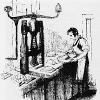
|
The crucial invention which allowed the
mass-production of tiles was made in 1840, when Richard Prosser discovered
that it was possible to compact dust clay using a press, and thence to
make tiles, rather than using damp plastic clay. The tiles were less
moist, giving a faster drying time, and warped less during firing.
|
|
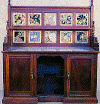
|
The great Victorian tile boom began around 1850
and continued until the end of the century. Many tilemaking firms were
involved, and tiles appeared in almost all types of building and even on
furniture, for instance wash-stands and dressing tables.
|
|

|
Minton’s of Stoke evolved into several other
firms including Minton Hollins, while another major concern, Maw & Co,
moved to Jackfield, Shropshire in 1883; the Craven Dunnill works were
already there. Doulton’s worked from Lambeth in London, and Burmantofts
was the trademark of a Leeds firm.
|
|

|
These firms made not only tiles but glazed
faience, a type of glazed ceramic slab which could be manufactured in
shapes to suit varied buildings; it was often used on pubs and – in this
case – shopping arcades. Burmantofts were particular specialists in this
ware.
|
|

|
And then there was terracotta, also made in
large blocks for exterior use but unglazed, and coming in colours ranging
from buff through salmon-pink to deep reddy-brown. Specialist terracotta
makers included two Ruabon firms, Dennis and Edwards, as well as Hathern
from Loughborough, although many of the larger tile manufacturers also
produced both glazed faience and terracotta.
|
|
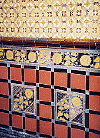
|
There was a vast range of techniques available
for decorating tiles, from hand-painting (with its many variations)
through printing, which included transfer printing and even photographic
methods as well as silk-screen, to relief decoration (including
tube-lining) and more besides. The exact technique used can be difficult to
identify.
|
|

|
Tiles were used both inside buildings and
outside, as a hard- wearing surface and as a decorative wall or floor
covering. Buildings ranging from pubs to offices to hospitals to shops to
theatres and practically anything else were decorated with tiles around
the turn of the century. Tilemaking was an important industry, with many
manufacturers having significant overseas trade.
|
|
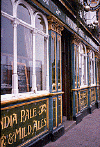
|
And tiles (or, indeed terracotta and glazed
faience) could easily be personalised, given the logo of a company or the
initials of a person; this made them most attractive to, for instance,
brewers, who could brand all their own pubs using distinctive ceramic
facades rather than simple signs. Shop chains, for instance butchers, fish
shops, dairies and florists also used ceramic logos.
|
|
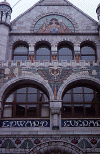
|
From about 1895 to 1910, Art Nouveau tiles
became popular, with most of the larger manufacturers making tiles or
panels in the style. In a radical departure, designer W. J. Neatby of
Doulton’s produced several Art Nouveau ceramic facades and interiors in
striking colours, including Harrod’s and Bristol’s Everard Building.
|
|
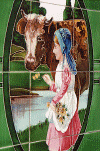
|
Following the First World War, plain tiling
became more fashionable than pictorial tiles, but some firms, such as
Carter’s of Poole, continued to specialise in decorative designs. Duncan’s
of Glasgow, established in 1865, produced a huge number of
tube-lined panels for local shops, almost all of which have now
disappeared, although this 1920s Buttercup Dairy panel survives.
|
|

|
A few smaller firms also managed to prosper
between the wars, including Dunsmore of London, who produced unusual
stencilled and sprayed tiles showing birds and fish. This example was used
to enliven the exterior of a housing development in Camden.
|
|
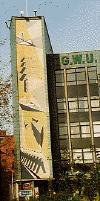
|
After the Second World War, tilemaking resumed
only slowly, and manufacturers attempted to cut costs by mechanising
production. In the 1950s the design emphasis was on geometric patterns,
but some figurative designs were still made. During the 1950s-1970s tiles
were popular as a facing material for public buildings.
|
|
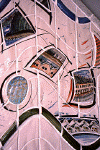
|
By the 1980s tiles were undergoing a revival as
small-scale craft tilemakers set up thriving businesses. Community
projects, where local people designed and made tiles, became popular.
Reviving an old tradition, tiles were increasingly used to decorate
hospitals.
|
|

|
At the turn of the millennium, tiles –
colourful, individual, stylish and fashionable – have become almost as
popular as they were a century ago. They are again being used to decorate
homes and proclaim company identities, with a vast range of designs
available in many differing techniques. These are tiles for a new century,
but still with the old virtues which originally made them popular.
|



















